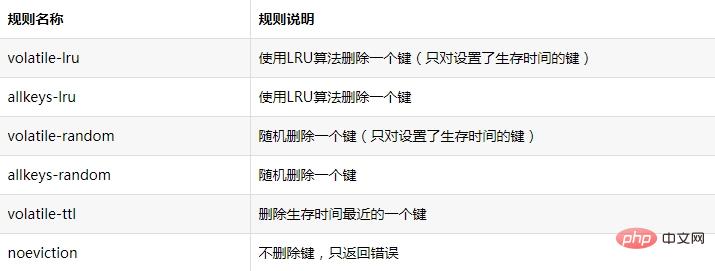Solution to redis memory full

Redis memory is full solution:
1, increase memory;
2, use memory elimination strategy.
3, Redis cluster.
Let’s focus on the second and third solutions:
The second one:
We know that the redis settings configuration file The maxmemory parameter can control its maximum available memory size (bytes).
So what should I do when the required memory exceeds maxmemory?
At this time, the maxmemory-policy in the configuration file comes into play.
The default value is noeviction.
Below I will list the elimination rules for deleting redis keys when the available memory is insufficient.

LRU algorithm, least recently used, least recently used algorithm. That is to say, the least recently used key is deleted by default.
But you must pay attention to one thing! Redis does not accurately delete the least recently used key among all keys, but randomly selects 3 keys and deletes the least recently used key among these three keys.
Then the number 3 can also be set, and the corresponding location is maxmeory-samples in the configuration file.
The third method:
Redis only supports single instance, memory Generally up to 10~20GB. For systems with 100 to 200GB of memory, it needs to be supported through clustering.
Redis cluster has three methods: client sharding, proxy sharding, RedisCluster
Client sharding
Implement routing through business code
Advantages: You can control the sharding algorithm yourself, and the performance is better than that of the proxy
Disadvantages: High maintenance costs, expansion/shrinking and other operation and maintenance operations require your own research and development
Agent Sharding
The agent receives data requests from the business program and distributes these requests to the correct Redis instance according to the routing rules and returns them to the business program. Implemented using middleware such as Twemproxy and Codis.
Advantages: Easy operation and maintenance, the program does not need to worry about how to connect the Redis instance
Disadvantages: It will cause performance consumption (about 20%), cannot smoothly expand/shrink, and needs to execute scripts to migrate data , inconvenient (Codis optimizes and implements pre-sharding based on Twemproxy to achieve Auto Rebalance).
Redis Cluster
Advantages: Official cluster solution, no central node, direct connection to the client, good performance
Disadvantages: The solution is too Heavy, unable to smoothly expand/shrink, need to execute the corresponding script, inconvenient, too new, no corresponding mature solution case
For more redis knowledge, please pay attention to the redis introductory tutorial column.
The above is the detailed content of Solution to redis memory full. For more information, please follow other related articles on the PHP Chinese website!

Hot AI Tools

Undresser.AI Undress
AI-powered app for creating realistic nude photos

AI Clothes Remover
Online AI tool for removing clothes from photos.

Undress AI Tool
Undress images for free

Clothoff.io
AI clothes remover

AI Hentai Generator
Generate AI Hentai for free.

Hot Article

Hot Tools

Notepad++7.3.1
Easy-to-use and free code editor

SublimeText3 Chinese version
Chinese version, very easy to use

Zend Studio 13.0.1
Powerful PHP integrated development environment

Dreamweaver CS6
Visual web development tools

SublimeText3 Mac version
God-level code editing software (SublimeText3)

Hot Topics
 1386
1386
 52
52
 How to build the redis cluster mode
Apr 10, 2025 pm 10:15 PM
How to build the redis cluster mode
Apr 10, 2025 pm 10:15 PM
Redis cluster mode deploys Redis instances to multiple servers through sharding, improving scalability and availability. The construction steps are as follows: Create odd Redis instances with different ports; Create 3 sentinel instances, monitor Redis instances and failover; configure sentinel configuration files, add monitoring Redis instance information and failover settings; configure Redis instance configuration files, enable cluster mode and specify the cluster information file path; create nodes.conf file, containing information of each Redis instance; start the cluster, execute the create command to create a cluster and specify the number of replicas; log in to the cluster to execute the CLUSTER INFO command to verify the cluster status; make
 How to clear redis data
Apr 10, 2025 pm 10:06 PM
How to clear redis data
Apr 10, 2025 pm 10:06 PM
How to clear Redis data: Use the FLUSHALL command to clear all key values. Use the FLUSHDB command to clear the key value of the currently selected database. Use SELECT to switch databases, and then use FLUSHDB to clear multiple databases. Use the DEL command to delete a specific key. Use the redis-cli tool to clear the data.
 How to use the redis command
Apr 10, 2025 pm 08:45 PM
How to use the redis command
Apr 10, 2025 pm 08:45 PM
Using the Redis directive requires the following steps: Open the Redis client. Enter the command (verb key value). Provides the required parameters (varies from instruction to instruction). Press Enter to execute the command. Redis returns a response indicating the result of the operation (usually OK or -ERR).
 How to read redis queue
Apr 10, 2025 pm 10:12 PM
How to read redis queue
Apr 10, 2025 pm 10:12 PM
To read a queue from Redis, you need to get the queue name, read the elements using the LPOP command, and process the empty queue. The specific steps are as follows: Get the queue name: name it with the prefix of "queue:" such as "queue:my-queue". Use the LPOP command: Eject the element from the head of the queue and return its value, such as LPOP queue:my-queue. Processing empty queues: If the queue is empty, LPOP returns nil, and you can check whether the queue exists before reading the element.
 How to use redis lock
Apr 10, 2025 pm 08:39 PM
How to use redis lock
Apr 10, 2025 pm 08:39 PM
Using Redis to lock operations requires obtaining the lock through the SETNX command, and then using the EXPIRE command to set the expiration time. The specific steps are: (1) Use the SETNX command to try to set a key-value pair; (2) Use the EXPIRE command to set the expiration time for the lock; (3) Use the DEL command to delete the lock when the lock is no longer needed.
 How to implement the underlying redis
Apr 10, 2025 pm 07:21 PM
How to implement the underlying redis
Apr 10, 2025 pm 07:21 PM
Redis uses hash tables to store data and supports data structures such as strings, lists, hash tables, collections and ordered collections. Redis persists data through snapshots (RDB) and append write-only (AOF) mechanisms. Redis uses master-slave replication to improve data availability. Redis uses a single-threaded event loop to handle connections and commands to ensure data atomicity and consistency. Redis sets the expiration time for the key and uses the lazy delete mechanism to delete the expiration key.
 How to read the source code of redis
Apr 10, 2025 pm 08:27 PM
How to read the source code of redis
Apr 10, 2025 pm 08:27 PM
The best way to understand Redis source code is to go step by step: get familiar with the basics of Redis. Select a specific module or function as the starting point. Start with the entry point of the module or function and view the code line by line. View the code through the function call chain. Be familiar with the underlying data structures used by Redis. Identify the algorithm used by Redis.
 How to make message middleware for redis
Apr 10, 2025 pm 07:51 PM
How to make message middleware for redis
Apr 10, 2025 pm 07:51 PM
Redis, as a message middleware, supports production-consumption models, can persist messages and ensure reliable delivery. Using Redis as the message middleware enables low latency, reliable and scalable messaging.




